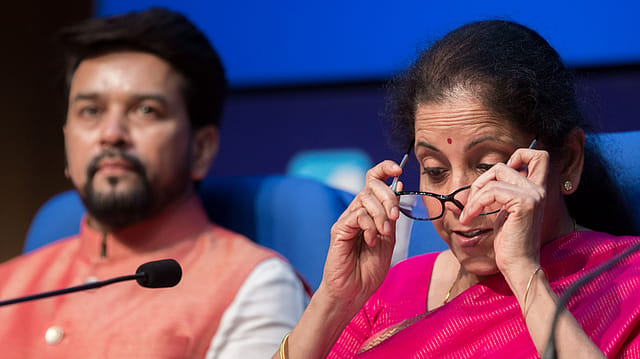Budget 2021: Living up to the expectations
ADVERTISEMENT

The first paperless Budget in the history of independent India has driven the Sensex over 2000 points; and the investors have given thumbs up to the Budget announcements. Prima facie, the Budget seems to have lived up to the expectations of many.
The Budget comes with a package of around ₹27 lakh crore, and aims to tackle the Covid-19 pandemic, and to become ‘Atmanirbhar Bharat’. The Budget proposals for 2021-2022 rest on six pillars – (a) Health and Well-being; (b) Physical and Financial Capital, and Infrastructure; (c) Inclusive Development for Aspirational India; (d) Reinvigorating Human Capital; (e) Innovation and R&D; and (f) Minimum Government and Maximum Governance.
With two vaccines (Covaxin and Covishield) already approved, and two more in the pipeline, the government is proposing to launch a centrally sponsored scheme – the Prime Minister Atmanirbhar Swasth Bharat Yojna, with an outlay of ₹64,180 crores over six years. Out of this, an amount of ₹35,000 crores will be spent for the vaccination drive, and the government has indicated its committed to spending more, if required.
It is notable that the country’s health Budget has increased by 138% since last year. It is expected that capacities of primary, secondary and tertiary care systems be developed, national institutions be strengthened, and new institutions be set up to detect and cure emerging diseases. The Budget also aims to improve health systems, ensure universal coverage of water supply (with the launch of Jal Jeevan Mission) and provide clean air for urban centres with a million plus population. Further, vehicle voluntary scrapping policy is announced to phase out old and unfit vehicles, with an aim to reduce pollution and the import bill.
January 2026
Netflix, which has been in India for a decade, has successfully struck a balance between high-class premium content and pricing that attracts a range of customers. Find out how the U.S. streaming giant evolved in India, plus an exclusive interview with CEO Ted Sarandos. Also read about the Best Investments for 2026, and how rising growth and easing inflation will come in handy for finance minister Nirmala Sitharaman as she prepares Budget 2026.
The next key pillar is the ‘Physical and Financial Capital and Infrastructure’, and with a view to achieve a $5 trillion economy, the government has announced production linked incentive schemes to create manufacturing global champions for 13 sectors, with a commitment of ₹1.97 lakh crores for five years starting FY 2021-22. This is expected to bring scale and size in key sectors, create manufacturing global champions, provide employment opportunities, and drive national GDP.
Realising that infrastructure needs long term debt financing; the government has allocated ₹20,000 crores to set up a professionally managed Development Financial Institution. Suitable amendments will also to be made to enable debt financing of InVITs and REITs by foreign portfolio investors.
Separately, as part of the asset monetization programme, core infrastructure assets such as: (a) NHAI operational toll roads; (b) transmission assets of PGCIL; and (c) oil and gas pipelines of GAIL, IOCL and HPCL, among others, will be rolled out to mop up funds. This is key to finance new infrastructure and construction activities.
With an aim to ensure inclusive development for aspirational India, the government has introduced a slew of measures with a view to benefit agriculture and related sectors, farmers’ welfare and rural India, and migrant workers. The government has reiterated its commitment for the welfare of farmers, and “…the MSP regime has undergone a sea change to assure price that is at least 1.5 times the cost of production...”. In 2020-21 alone, an amount of ₹75,060 crores was paid to farmers. In order to formulate health, housing, skill, insurance and food schemes for migrant workers, the government is proposing to launch a portal to collect information on gig, building and construction workers, among others.
Improving the quality of human capital has also occupied a top priority in the Budget speech. The government is proposing to: (a) qualitatively strengthen more than 15,000 schools; (b) introduce legislation to set up Higher Education Commission of India (for standard-setting, accreditation, regulation and funding); and (c) enhance apprenticeship opportunities for our youth, with an outlay of ₹3000 crores.
For strengthening R&D ecosystem in the country and promoting innovation, the National Research Foundation will be set up with an outlay of ₹50,000 crores over five years. Further, an amount of ₹1500 crores is earmarked to provide financial incentives to promote digital transactions.
For the last pillar of ‘Minimum government and maximum governance’, the Finance Minister has announced to: (a) rationalise functioning of tribunals to provide speedy delivery of justice; (b) set up conciliation mechanism to provide ease of doing business for dealing with government agencies or CPSEs; (c) carry out the first digital census in India with an outlay of ₹3768 crores in 2021-22; and (d) allocate ₹1000 crores for the welfare of tea workers, especially women and children in Assam and West Bengal.
If the mechanics of implementation of these measures are properly planned, I am sure these announcements will go a long way in firstly, reviving the Covid-19 hit economy, and secondly, in laying sustainable measures to support the Indian economy in the long run.
Views are personal. The author is partner, general corporate, M&A and private equity, Shardul Amarchand Mangaldas & Co.
